THE LOCAL SCENE
AN EVER-CHANGING SEASCAPE
Alan McIntyre is a senior angler who’s spent much of his life fishing in and around metropolitan Adelaide. In this piece he takes a look back on how things have evolved – both for better and worse.
“
Time and tide wait for no man” – an ancient proverb that couldn’t be more true when it comes to fishing. Wasting time and ignoring the tide is going to cost you, but if you use both to your advantage, you’ll greatly increase your chances and enjoy the thrill and satisfaction of a great day out on the water.
Fortunately for me, I no longer have the burden of working full time, which allows me more opportunity to concentrate on fishing and boating – pastimes that have been a mad interest of mine since I was a young lad. I still have memories of going to Kangaroo Island with my mother as an eight-year old, and joining the crew on a charter boat. I can still smell the diesel exhaust from the old vessel we boarded, along with the enchanting view of the ocean and being captivated looking at the broken bottom of the coastal waters.
The supplied fishing gear that day was an old timber hand line with thin rope cord and a whiting rig attached with a heavy lead sinker. We didn’t have the luxury of braid and fluorocarbon line or sophisticated reels and rods made from space age nano-particle composite materials. This didn’t matter to me, though I can still distinctly remember watching the man next to me that day pulling fish after fish and wondering what I was doing wrong. That inquisitive, driven nature has been with me since.
Most of my fishing these days is off Adelaide’s metropolitan coast. I own one of the old 18-foot Lyndsay Fry-built Seafarers, set up to meet my needs as a fisherman who spends most of his time out on the water solo. I concentrate on all the popular species like gar, tommies, squid and snook, but overall I mostly target whiting. For the most part I’m reasonably successful, however it hasn’t always been that way. Like many, I’ve had to work out the secrets.
King George whiting fishing off the metropolitan coast is as good as it’s ever been, in my opinion, with the best period moths between October and April. During this period I find the fish are scattered widely, from inshore to out deeper in about 20m of water, and this season has been exceptional. Amongst the whiting most of the drops also have large schools of garfish, red mullet and mackerel, along with a good supply of squid – a handy bycatch as the tentacles make for some of the best whiting bait.
The metro whiting may not be those enviable size specimens that appear in some of our regional locations. However, they’re certainly well-conditioned fish all the same, and when you’re on a hot bite, it’s as good a day as you could have anywhere for a much smaller outlay. It sure lifts the spirits of a fisherman like me. Just ask my wife, Allison, when I get home with a bag of quality whiting!

It’s been a great season for blue swimmers in local waters
Before all this happens though, to achieve reasonable success you may need to have the right attitude, and 90 per cent of my fishing is done before I leave home. It’s more than simply having all my rigs ready, fuel in the boat and bait handy. For example, I only ever use hooks once. That’s no surprise, but I will use the rig they hang offtwo or three times. If that rig is in good condition, I find that the line has all the stretch taken out of it. This sounds a bit peculiar I know, but it’s significant.
I only use 20lb Black Magic leader and Daiichi size 6 long shank hooks, (I am experimenting with Mustad circle hooks at present) and my knives are sharp. I’ve done an inventory check of my tackle box (yes, it’s just a box), I study the tide and weather charts days beforehand and, if necessary, look back over my records. I can’t put enough emphasis on records.
Everything in my boat is compliant and in date. I don’t want to be having lengthy chats with the authorities at the ramp when it’s time to go and, as I said before, wasting time is costing fish. I’m also very targeted with when and where I go fishing – and this is where records pay off. I now spend less time running around achieving nothing, and instead back myself and head to spots that I’m confident will produce fish when time and tides all line up. I could bore you silly with more of my idiosyncrasies, but if you’re focused and determined like me, you’ll work it out.
As mentioned earlier, I’ve been fishing and boating a lot of years. My boat licence is a tattered old piece of paper I paid $5.00 for about 50 years ago, and I learnt to launch and retrieve at the old Glenelg boat ramp. It was located at the end of the Patalwalonga outlet just west of the lock, and is now built over with multimillion dollar homes. These were great times, and there was a real community amongst the regular boat owners.
After launching the boat, we’d head out to popular grounds (assuming we’d managed to safely cross the sand bar or our trailer wheels didn’t fall over the edge of the ramp) and meet up with all the others. Sometimes the cluster of boats would be so tightly anchored up, almost raftered together, that you could just about walk from boat to boat. You sure had to rely on your skills back then. That doesn’t seem to happen anymore, and maybe just as well, as you can imagine the chaos that would happen at times.
I loved it and would often join in on the banter between skippers and crew as we caught fish. We didn’t have mobile phones back then or sophisticated sounders with chart plotters, and this was well before GPS became popular. Our fishing spots were located using grid lines from land marks on the shore against structures in the distance or the TV towers on Mount Lofty. Surprisingly, they were quite accurate. One site in particular was Fred’s rock, some distance out, that you could pinpoint using this method. It was just one small outcrop on a flat, featureless bottom.
In essence, the fishing methods and techniques I used back then are pretty much based around the same as a I use today, but there are two things I think have made life a lot easier – GPS and electric anchor winches, but even without these luxuries I reckon I could still do well.
I’ve used a variety of rods and reels over the years, and these days I pretty much settle for 2500 size reels with 20lb braid. I find some of the thin PE type braid too difficult to deal with, and I like braid that has a bit of texture to it. I never spend more than $100 on my rods, and use brands like Samaki or similar. The only drawback with these fine gauge rods is that I’ve been known to break one or two if I’m a little too harsh with them, though one particular rod that I broke the tip off twice is now one of my favourites after repairing it. Besides that, I’ve also stepped on them, left them sitting too high as I reversed the boat back into the garage, and lost the odd one over the side. However, one rod I have in particular that has outlived all others is the old robust Ugly Stik. There’s no doubt about those rods, they are pretty much unbreakable. For old time’s sake, and for something different, I might break out a simple hand line spooled with 30lb mono and use that for whiting when they’re eager to take a bait. The technique is simple; just get yourself established in one spot on the boat, have everything handy and don’t move your feet. As you pull the line in, let it drop directly on the floor. When you toss the rig over the side, take the opportunity to rinse your hands in water, grab the line as it hits the bottom and start the whole cycle over again.

A typical local KG

A lovely little king from Glenelg

Hopefully, snapper will be available again soon
About the only bait I buy is pilchards, otherwise I collect my own. I’ll generally start with cockles, using two rods and then, when the fish become more active, I go back to using one rod. When it gets busy, there’s the risk of tangles with two rods, which can cost you time. Apart from that I might use bungum worms, and if I’ve managed to pull a few squid, I’ll change over to fresh long, soft candles cut into small lengths.
My berley generally consists of left over cockles, pilchards and, if I have them, crab shells. All this is mashed up with bread, then divided up and frozen. Nothing goes to waste, everything is used and has a purpose. The whiting frames are used for crab bait, or in a string bag when I head down to the beach to collect bungum worms. It’s so disappointing when I’m at the wash down bays and see unused bait still in the plastic bags thrown in the landfill bin. This can at least be unloaded over the side and given back to the sea. Even unused ice can be recycled. It’s not that hard.
Sadly, I don’t think there has been much improvement in boat ramps, and I’m fiercely of the opinion that all boat ramps in SA should be free to use, as they are in other states. In the meantime, if you’re launching at busy metro ramp (or some regional ramps during peak periods), it’s a good idea to have your boat and trailer ready, which should be the case anyway. Move your boat to the end of the pontoon after launching, and up forward when retrieving, to allow others to move in safely around you. Clear the ramp before removing your bungs, and never go up or down a ramp without the safety chain attached. All this will help save you and others time and keep everyone a lot happier.
The good old days were wonderful times, and I met some real characters and made friends with a lot of experienced fishermen. The old Henley Fshing Club that met in the front bar of the Henley Hotel was a great place to network with others. Sadly though, that finished up many years ago, and more recently the ETSA boat club that I was a member of for 40-odd years has ceased due to the demolishing of the A station on Torrens Island. The boat ramp there was well maintained in a very secure site on the North Arm.
Getting older is a blessing, and I would appeal to those in authority to recognise the benefits of an active life and remove any encumbrances, fees and charges, so we can live more fulfilling lives. And by the way, I’m always up for a chat on the water or at the ramp, so don’t be shy if you see me launching the Seafarer at West Beach on a sunny Saturday morning!